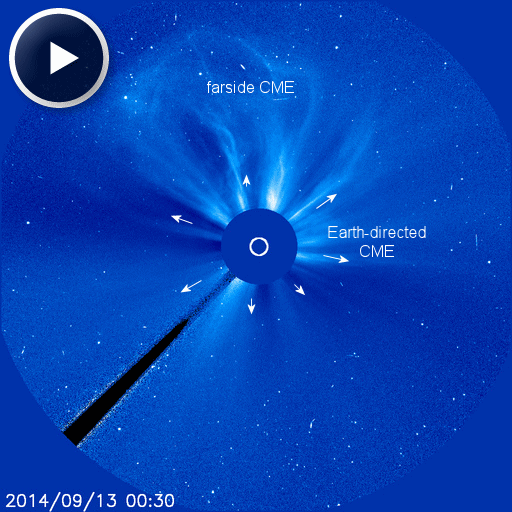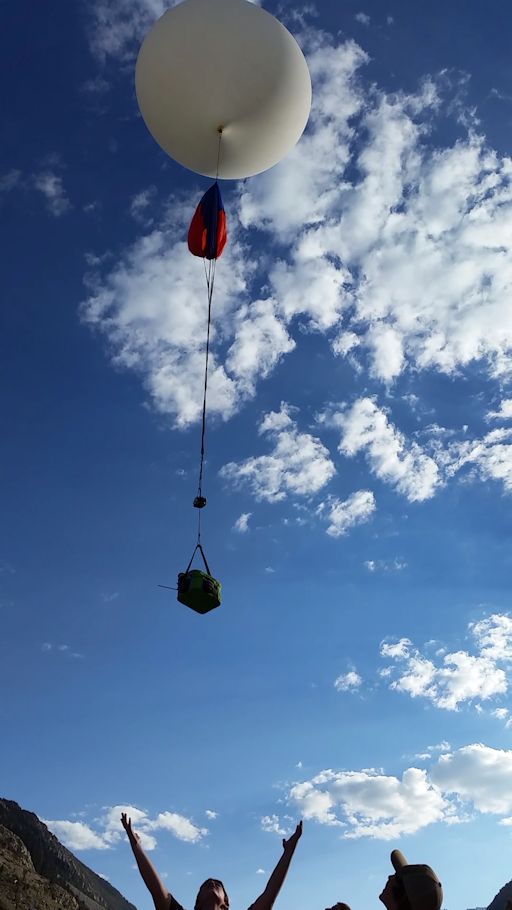When is the best time to see auroras? Where is the best place to go? And how do you photograph them? These questions and more are answered in a new book, Northern Lights - a Guide, by Pal Brekke & Fredrik Broms. | | | QUIET WITH A CHANCE OF FLARES: Solar activity is low. However, sunspots AR2157, AR2158 and AR2164 have 'beta-gamma' magnetic fields that harbor energy for significant eruptions. NOAA forecasters estimate a 50% chance of M-class flares on Sept. 16th. Aurora alerts: text, voice INCOMING CME: Another CME is en route to Earth. It was launched in our direction four days ago by the eruption of a magnetic filament near the center of the solar disk. This movie from the Solar and Heliospheric Observatory shows the Earth-directed CME almost overwhelmed, visually, by a brighter farside CME headed in the opposite direction: 
The impact won't be as effective as the double-blow Earth experienced on Sept. 12th, when two CMEs hit in less than 24 hours. Nevertheless, NOAA forecasters estimate a 50% chance of polar geomagnetic storms on Sept. 17th when the CME arrives. (Note: Yesterday we wrote that the CME would arrive on Sept. 16th, however, a revised analysis of its speed suggests a later arrival.) High-latitude sky watchers should be alert for auroras. Aurora alerts: text, voice Realtime Aurora Photo Gallery SPACE WEATHER PROBE LAUNCHED: On Sept 12th, while the web site Spaceweather.com was down during the most intense geomagnetic storm of the year, the webmaster shook off the stress by going outside ... and launching a space weather probe. Carried aloft by a helium balloon, the probe was prepared and released by the students of Earth to Sky Calculus just as the planetary K-index hit 7: 
Inside the balloon's payload, there was a high-energy radiation sensor, a cryogenic thermometer, multiple GPS altimeters and trackers, and three cameras to record the flight. The launch was the latest in an ongoing series of suborbital balloon flights to measure the effect of stormy space weather on Earth's atmosphere from ground level to the stratosphere. Soon, the group will release an entire year's worth of data of interest to commercial aviation and space tourism. After a 2.5 hour flight, the payload has parachuted back to Earth and landed in the Inyo Mountains of central California. Update: The payload has been recovered. Stay tuned for images and data. Realtime Space Weather Photo Gallery
Realtime Comet Photo Gallery Every night, a network of NASA all-sky cameras scans the skies above the United States for meteoritic fireballs. Automated software maintained by NASA's Meteoroid Environment Office calculates their orbits, velocity, penetration depth in Earth's atmosphere and many other characteristics. Daily results are presented here on Spaceweather.com. On Sep. 16, 2014, the network reported 27 fireballs.
(27 sporadics)  In this diagram of the inner solar system, all of the fireball orbits intersect at a single point--Earth. The orbits are color-coded by velocity, from slow (red) to fast (blue). [Larger image] [movies] Potentially Hazardous Asteroids ( PHAs) are space rocks larger than approximately 100m that can come closer to Earth than 0.05 AU. None of the known PHAs is on a collision course with our planet, although astronomers are finding new ones all the time. On September 16, 2014 there were 1500 potentially hazardous asteroids. Notes: LD means "Lunar Distance." 1 LD = 384,401 km, the distance between Earth and the Moon. 1 LD also equals 0.00256 AU. MAG is the visual magnitude of the asteroid on the date of closest approach. | | The official U.S. government space weather bureau | | | The first place to look for information about sundogs, pillars, rainbows and related phenomena. | | | Researchers call it a "Hubble for the sun." SDO is the most advanced solar observatory ever. | | | 3D views of the sun from NASA's Solar and Terrestrial Relations Observatory | | | Realtime and archival images of the Sun from SOHO. | | | from the NOAA Space Environment Center | | | the underlying science of space weather | | 
